Description
What is keyword research?
Keyword research is part of SEO (search engine optimization). It’s the work someone does to come up with an extensive list of keywords they would like a website to rank for. To obtain such a list, website owners need to dig into their desired audience and search engines. What search terms do people type into Google when looking for a particular product, service, business or type of organization? And what do they expect to find? With this list, website owners can create content that will attract more high-quality traffic to their site. Keyword research is never finished: repeating it regularly is essential to stay up-to-date!
Why is keyword research important?
Proper keyword research is important because it will make clear what search terms your audience uses. At Techaxis, we frequently come across business owners who used one set of words when describing their products, while their target audience used a completely different set of words. As a result, potential customers can’t find those websites, because of a mismatch in word use.
For instance, sometimes, a marketing department decides to give a product a not-so-common name. This can be a smart marketing decision: People could remember your product more easily. If you rent out vacation cottages instead of vacation homes, you might stand out. But beware: Very few people search for [vacation cottages]. If you optimize your text for this term, you’ll probably rank well on this specific term. However, you won’t generate a lot of traffic and you’ll miss a large part of your potential audience because they use other words.
You’ll probably understand that it doesn’t make any sense to optimize for words that people don’t use. Thorough keyword research makes sure that you use the same words as your target audience and this makes the whole effort of optimizing your website far more worthwhile. In addition, by looking at search intent, you find out what exactly your audience is looking for. Those queries should get an answer in the form of quality content.
Essential concepts of keyword research
Before we jump to doing keyword research, we’ll briefly explain some of its essential concepts:
A focus keyword or keyphrase is the word or phrase you want a certain page on your site to be found for in Google. You determine your set of focus keyphrases by doing keyword research.
Long-tail Keywords are more specific and less commonly searched for than head keywords. Long-tail keywords focus on a niche. The longer and more specific search terms are, the easier it will be to rank for them since there will be less competition. Even though there are less people searching for these terms, they might be more motivated to buy, subscribe, sign up or whatever you’d like them to do.
Your keyword strategy is about the decisions you make based on your keyword research. For instance, what content are you going to create first? Will you focus on the head or tail? How and where will you publish it? Will you create a piece of writing, a post or a product page, a video tutorial or an infographic?
Digging into search intent is key here: you have to discover what a searcher actually wants or needs. You’re not just looking at keywords, but the underlying goals of what a searcher wants to know, do or buy. Your content should provide a solution to the searcher’s “problem”. This is also known as content design.
How to do keyword research in 10 steps
There are 10 crucial steps to follow when carrying out keyword research. Here, we’ll guide you through the process step-by-step and give you practical tips to conduct your own keyword research:
Think about your mission and determine your SEO goals
Before starting anything, think about your mission. Reflect on questions such as: What is the main goal of your business or organization? What makes it special? Who exactly are you trying to reach? And, what promises do you make on your website? Take your time and literally write down your mission. Once you’re able to answer these questions in detail, you’ll have taken the first and most important step in developing your keyword strategy.
The market you’re in determines whether you’ll be able to rank high with your chosen keywords. Some markets are highly competitive, with large companies dominating the search results. These companies have huge budgets for marketing in general and SEO in particular. Competing in these markets is tough, so ranking in these markets is also going to be tough.
Perhaps you sell cruises to Hawaii. You offer great facilities for children, making the cruises especially suitable for parents with younger kids. Offering the best family-friendly cruises to Hawaii could very well be what makes your service unique. So, look for the thing that makes your product stand out from the competition. This should be your mission, your niche – and this is what you have to offer your audience.
If you’re launching into a competitive market, your best bet is to start out small. Once you ‘own’ a small part of that niche and become a bigger name in your business area, you could try to level up and sell your cruises to a larger (more general) audience. Your mission will then become more general as well. The scope of your business mission should align with your SEO goals, too. Be realistic about what kind of rankings you can achieve with the size of your business, and focus on what will help you achieve your mission.
Make a list of keywords you think people might search for
The second step is creating a list of your keywords, preferably in a spreadsheet, such as Google Sheets or Excel. With your mission in mind, try to get into the heads of your desired audience. What will these people be looking for? What kind of search terms could they be using while looking for your amazing service or product? Which of their “problems” does your product solve? Write down as many answers as possible. If your mission is clear, you will have a pretty clear image of your niche and unique selling points (the things that set your business apart from others). These are the search terms you want to be found for.
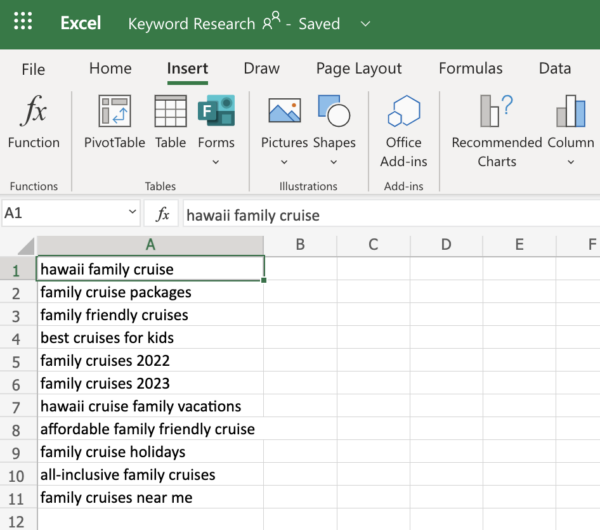
Research the keywords you’ve come up with
After you’ve created this first list, it’s time to dive a bit deeper into your keywords. Luckily, there are some tools that make your keyword research a bit easier.
The first is Google itself. Google the keywords you already came up with and check the searches Google suggests while you are typing. Those are the questions people actually asked Google! You can also check out the “related searches” on Google’s results page.
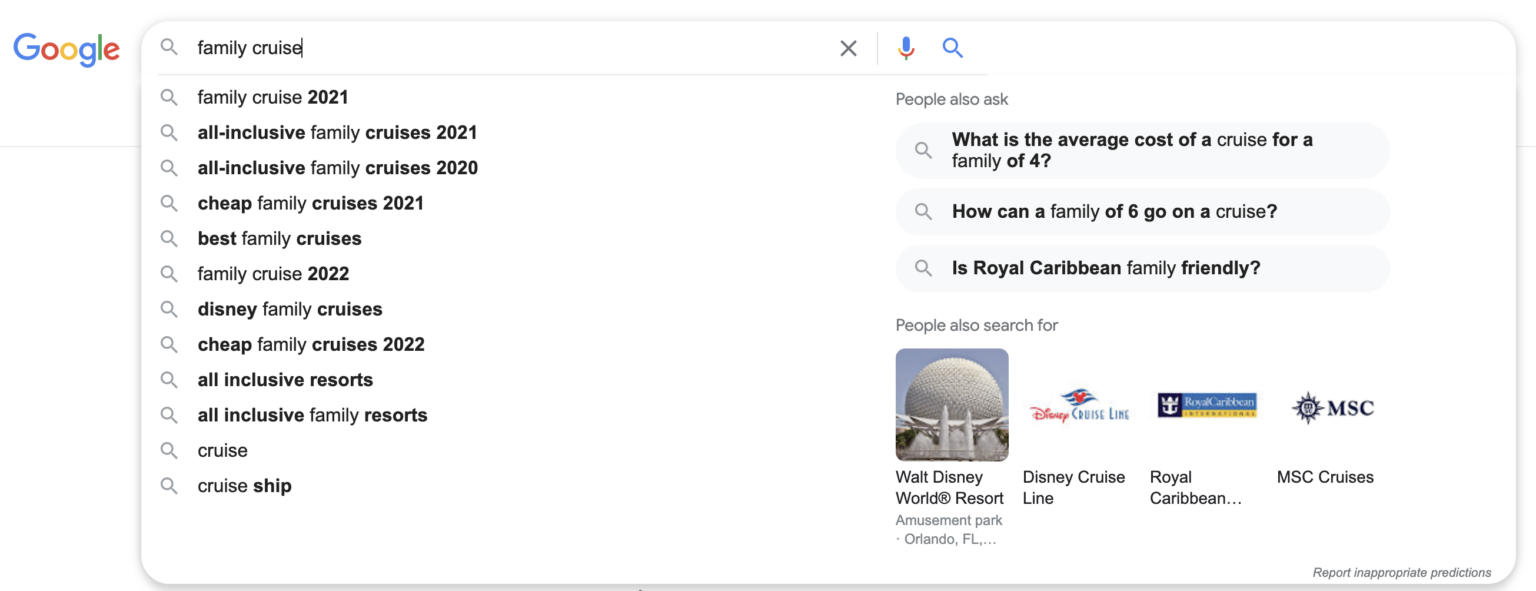
Use your research to find long-tail variants of your keywords
When people start out with keyword research, they tend to focus on very popular “head” terms. Unfortunately, those head keywords are mostly taken by large businesses. Long-tail Keywords, on the other hand, get less search traffic, but there’s less competition too. Therefore it’s easier for you to rank on those keywords. Moreover, long-tail keywords even have a higher conversion value, as they focus more on a specific product or topic.
A long-tail keyword often is longer and more focused than a head term. If your head term is [puppy training], a long-tail keyword could be [positive puppy training for Labradoodles in Amsterdam]. Using the tools mentioned in step 3 will also help you find more long-tail keywords. You might also find some less-searched variants of your keywords, you can benefit from using these too.
Don’t forget to add the long-tail keywords and your keyword variants to your spreadsheet too. Put the head terms in the first column and add (multiple) columns for long-tail keywords and variants. This will also help you create a proper site structure later on. The more long-tail your search term is, the further down into your site structure its landing page belongs.
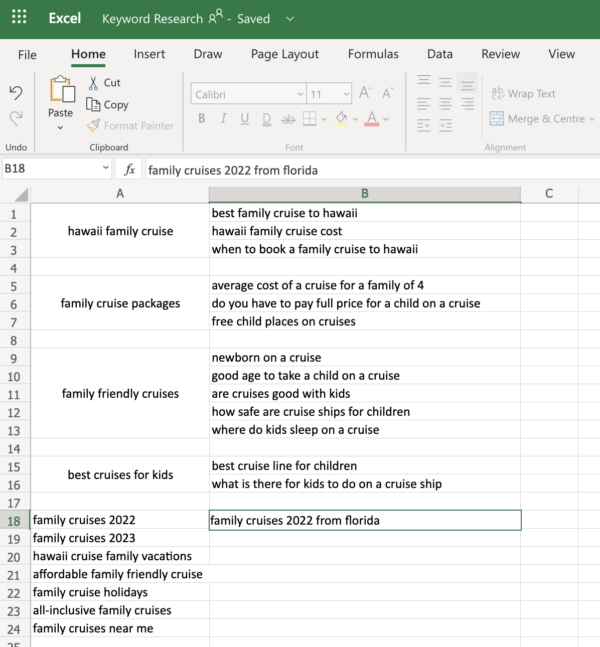
Analyze your competition for those keywords
Whether you should go after long-tail keywords largely depends on your competition. If the competition in your niche is high, you’ll have a hard time ranking on competitive head terms. If you have little competition, you’ll be able to rank for more of your head terms. So you’ll need to do some benchmarking for SEO.
Google the keywords that came out of your keyword research. Start with your most ‘head’ term. Check out the search engine result page (SERP). These are the websites you’ll be competing against once you optimize your content for such a keyword. Take a closer look: Do you see professional websites? Company websites? Are you ‘equal’ to these companies? Does your website fit among these sites? Is your company of similar size and does it have as much influence in your niche?
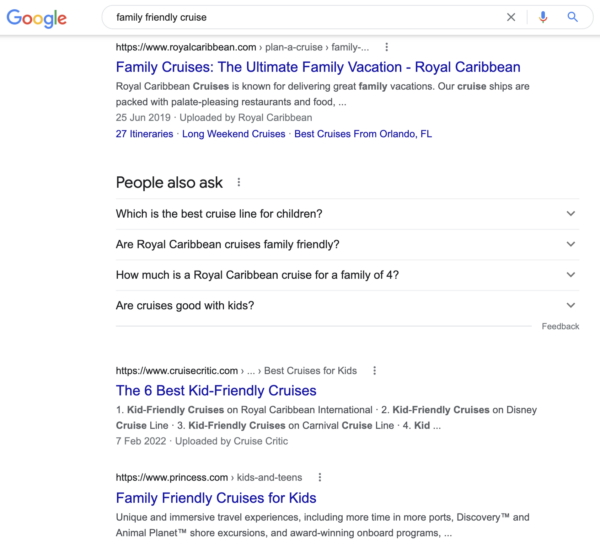
It’s harder to rank when you’re competing against sites with strong brand names, like Royal Caribbean and Princess in the example above. If brands are known from TV or radio commercials, your chances to rank high will become even smaller. But it won’t hurt to take a look at their content. Is the content well written and well optimized? If your competition has poor content, you might have a chance to outrank them!
Also, take a look at ads in Google. Are there any? If you have a Google Ads account you can check the pay-per-click value of each search term using their Keyword Planner tool. Search terms that have a high pay-per-click are usually also harder to rank for in the organic results.
Make sure to make notes in your spreadsheet about your findings for the keywords you’ve investigated! You can use colors like red, yellow, and green to mark which keywords are more or less competitive if you find that easier than writing notes.
Take a closer look at search intent for each keyword
Today’s SEO strategies should, for the most part, revolve around answering the questions people have or providing the best solution for their “problem”. Whenever someone enters a search query into a search engine, they are on a quest for something. Every type of question needs a specific answer.
Try to find out which intent your audience has when they type a certain keyphrase into Google. Do they have an informational intent (try to find information on a specific topic), navigational intent (want to access a specific website), commercial intent (want to research something before buying), or transactional intent (looking to buy something right now)?
Determine a keyword strategy – which keywords will you target?
Based on the data you’ve collected now, you can determine a keyword strategy. If you’ve followed the steps above, you should have a spreadsheet with a substantial amount of keyphrases, plus information about the competition and the search intent of your audience for those keyphrases.
Now think about this question: How does my website hold up compared to the websites in the SERPs? Are you of equal size and marketing budget? Then go ahead and focus on those head terms. If not: try more long-tail keywords first. Focusing on a whole bunch of long-tail keywords combined could very well attract a lot of traffic. Once you’ve managed to rank for those long-tail keywords, aiming for more head terms will become easier.
When you’ve decided where to jump in, think about the type of content: What was the search intent for my keyphrases? What is my audience looking for? But also, which content can I create that isn’t there yet, and how can I stand out in terms of quality or providing solutions? This will help you decide on the type of content you’re going to create.
Create optimized landing pages for your keywords
In theory, this step is out of the scope of keyword research itself. Nevertheless, creating awesome landing pages is essential if you want to get traffic to your website. So, you’ll need to build optimized landing pages for your search terms. You don’t have to create all these pages immediately – it can be a long-term effort. Your keyword strategy will help you prioritize.
For your most important keyphrases you’ll create cornerstone content articles; articles that provide the best possible content about that keyword – authoritative and all-encompassing. All your supporting long-tail articles should link to your cornerstone content pages. This is part of your internal linking strategy.
Evaluate if your keyword strategy is working and keep improving
Once you’ve done a thorough analysis of your chances to rank on each specific term, published some amazing articles (and optimized them accordingly), wait a little while. Check out your rankings. Does your article pop up? Did it hit the first page of Google’s SERPs? Or is it hidden away on page 2 or 3? Make sure to evaluate your results in the SERPs.
There are various ways to check how your content is performing in the search results. The simplest way is to Google the terms you’ve optimized your articles for. Another option is to use Google Search Console to find out which queries you’re ranking for. While the Google Search Console method is a bit more complicated, it can be a great way to find new opportunities! And finally, a third method is to use a keyword tracking tool to monitor your ranking.
However you do it, it’s always a good idea to check if your efforts are paying off. If you’re not able to rank on the first page, try to write another article, focused on an (even) more long-tail keyword. Make it a little bit more specific, more niche. And see how that goes. Evaluate again. Continue this process until you hit that first page of the SERPs!
Refresh your keyword research and your content regularly
As time goes on, things will change. Your audience may start using different words to search for what they want, so you might need to add new keywords to your sheet. Or the competitive landscape could change, making it easier or harder to target particular keywords. And besides all of those external changes — your site might be in a stronger position than it was when you started out, meaning you have the opportunity to target more head keywords.
All of these possibilities mean that it’s important to refresh your keyword research once in a while. These kinds of things are unlikely to change quickly, so refreshing your keyword research every month is probably too much. However, when you look at the situation from year to year, a lot can change. So you should take the time to update your sheet with the latest information once in a while. Don’t forget to keep your content fresh and up-to-date, too!
Quick keyword research
In an ideal world, you would do your keyword research, make a beautiful spreadsheet and create landing pages for each one. Your site structure would be flawless and you would blog and write every day making your site rank higher and higher in Google. But, we live in the real world.
Of course, your keyword research will not always be as extensive. And some posts or articles aren’t written as part of an awesome strategy, but just because the topic was in the news or something inspired you to write it. That’s just how these things work. But this doesn’t have to be a problem.
If you’re writing something that doesn’t exactly fit your strategy, this doesn’t mean you shouldn’t try to make that content rank. You could still use it to rank for something related to the terms in the list of your keyword strategy. Use tools mentioned in step 3 and Google Trends to quickly check which keyword you’d like to rank for. At least, take some time to think about how to make your article or blog fit your strategy. After all, if you are writing valuable content, you might as well make it rank!
Tips for keyword research
This all might sound pretty straight-forward, but we know it’s a lot of work and easier said than done. When put into practice, you might bump into some common issues or questions. Here we’ll give you some tips to make it work!
Prioritize your keyword list
How many keywords should you target? Well, we can’t tell you the exact number of keywords you should have, but we can tell you that you need a lot of them – as many as you can think of. However, more than 1000 keywords is probably too many! Even if you’re a reasonably small business, you’ll probably end up with a couple of hundred keywords.
But there’s no need to create pages for all of these straight away. You can add content bit by bit. Think about which keywords you want to rank for now (perhaps the more long-tail ones?) and which ones aren’t as important right away. Understand your priorities and plan the creation of your content.
A focus keyphrase and its synonyms only need one page
In the past, each of the keywords you wanted to be found for got its own landing page. Today, however, search engines are so smart that they mostly use search intent to give searchers the best answer to their questions. The page that answers those questions best will rank on top. Search engines also understand subtle differences between keywords, so you don’t have to create landing pages for every subtle variation of a keyword, like synonyms.
That doesn’t mean you shouldn’t use synonyms! In fact, synonyms can really improve the readability of your copy, so make sure to use them.
Add related keyphrases to help Google understand your text
Related keyphrases are words and concepts that deepen and broaden the understanding of your focus keyphrase. By using related keyphrases in your text you can paint a complete picture of your focus keyphrase in the article you’re writing.
So, how to find the related keyphrases that will help you rank with your focus keyphrase? You might be able to think of a few related keyphrases, but we think proper keyword data is the safest bet.
Check out results for singular and plural keywords
Should you aim for the singular or the plural keyword? Well, this depends on the query. As Google learns more about the search intent of your query, it is able to better guess what you’re looking for. For instance, if you search for book, you get different results than if you search for books. Apparently Google thinks that in the first case you’re looking for a definition, in the second case it believes you’re intending to buy a book. So make sure you know what you offer on your page and that it fits with the query and results Google gives on that query.
Use a keyphrase only once
Beware, you should not use your exact focus keyword more than once. If you do, your rankings might suffer from keyword cannibalization. Google has a hard time distinguishing between content that’s very alike. Therefore it might rank very similar posts or pages lower.
Ready? Start writing!
Keyword research should be the start of any sustainable SEO strategy. The result will be a long list of keywords for which you’d like to be found. But the hardest part is still ahead: writing all that content. You should write articles and blog posts on every single keyword you would like to be found for. That’s quite a challenge. Check out our ultimate guide to SEO copywriting to get started!
Read on: Are social media platforms becoming the new search engines? »




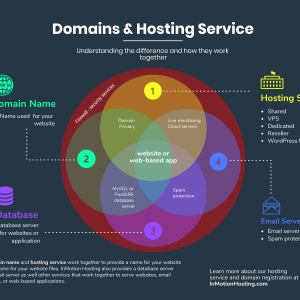






Reviews
There are no reviews yet.